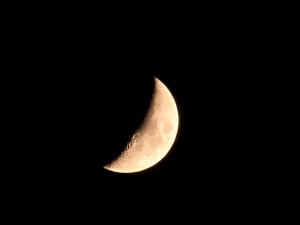Looking for design inspiration? Browse our curated collections!
June 13th, 2015 - 11:37 PM

Ever wonder how the pro photographers shoot the moon and you just get so amazed by their pictures. When your turn comes it just gets so annoying that you don't wanna see your camera for the next couple of days. Yeah it happens because you have yet to know that shooting moon is easy if you follow the right steps which i am going to tell you very soon as you read through.
I am being very honest with you guys here. This is my first best moon photo i have ever taken. Its taken from a 100$ Digital camera 5 years ago with 10x zoom. Yeah ofcouse i shot it in full zoom and i was influenced by a couple of photos in the internet and i decided to give it a try. And guess what the results are not too bad. In fact, the photograph above is a fairly decent shot for a Digital camera. You can see the tiny craters on the moon and its just so amazing.
This means that you can shoot like this too. Its nothing so professional in the beginning as you learn you can engage your creativity to get maximum results. You do not need those 800mm Super zoom (9000$) lenses for super pro shots. Its all about making the maximum use of whatever you have right now.
I assume you use a Digital camera with a decent zoom say 8x to 40x (It does not matter) as long as you have some zoom its good. And if you have a DSLR i assume you are with a 18-55mm lens or 18-200mm( Its still does not matter). Now what matters is a bit of your extra work. You need a tripod which you can buy and if you don't want to its okay.
What you do is fairly simple. You wait for the night and get your camera ready. You place your camera in a still surface,(or tripod). You have to some how place it in a position where it does not move at all. This requires you to do some little extra work. You can place it on a table or a chair out side and get some books if you need that extra grip. Place it and position it towards the moon and do not move it. It should be super still that's why tripod matters to some extent. Now set your camera to self - timer. Remember, that 10s when you shoot your school photo or family pictures. That is exactly what you do to shoot the moon. You zoom to the maximum which you camera offers.
Next you focus and maintain it. Now for a digital camera, it may take time to get it right but keep trying and you will some how get the right focus. They suck that way and for a DSLR use the manual focus. And then you just click. Its that simple like ABCD trust me and it not rocket science photography. You can then edit the image in photoshop to enhance the sharpness or crop it if the moon appears small.
In photoshop you play around with brightness, contrast and clarity. That's very simple and straight forward. Now this tip is for people who would like to give it a try with cheap cameras. Its not that they produce awful results, its just that they lack some bit some quality. Now if you do the same with a Professional camera you get the same results with a better image quality. But the difference is in the image editing and you don't have to do much and there is wider image processing functions with a DSLR. As you can shoot in RAW.
In my next post i will show you how to do it in a more Professional Way with expensive cameras.
Till then the best Digital camera to shoot the moon would be
1. Canon PowerShot SX60 HS Advanced Digital Camera, Black
- This is one camera that every wild life and nature photographer would recommend for beginners. Its the best till date. Get it if you are thinking to do some wild life photography. Trust me it has 50x zoom that gives you about 1200mm on a standard lens. That's 10000$ compressed into a single couple of hundred dollars camera. Guys get it , Get man, Oh my god i mean This is the camera for you if you just want a great camera.
Comments
There are no comments on this blog. Click here to post the first comment.